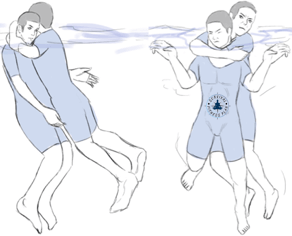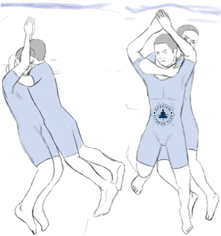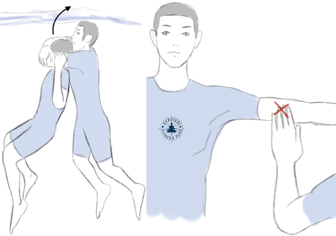How to Defend Yourself Against a Drowning Victim
Learn how to defend yourself against a drowning victim. A drowning victim can be dangerous to anyone that gets within arms reach of him. He can grab and pull you down with extreme strength (due to increased adrenalin) to save himself. This is why you should only use a tow rescue as a last resort, especially with a panicking victim.
GET YOUR FREE SWIM WORKOUTS AND WATER RESCUE SKILLS SCHEDULE
The information in this post is from the book “Swim Workouts and Water Rescue Skills” by Sam Fury.

Swim Workouts and Water Rescue Skills: Techniques to Swim Faster, Longer, and Safer (Survival Fitness Book 9)

Price Disclaimer
How to Defend Yourself Against a Drowning Victim
Practice these techniques on land first and then in the water. You want to be able to do them instinctively.
Hold escape techniques in the water are different to SFP Self-Defense techniques. They take into account the water and are non-violent. They are non-violent because the victim does not intend to harm you. His instinct for survival over-rides his ability to see the negative effects. Defend yourself and then help the victim if possible.
General Defense
Whenever a casualty tries to grab you, or as soon as you escape his grip, treat him as an obstruction. Adopt the defensive position by lying on your back with your feet pointed towards him. Kick your legs with the aim of making a big splash. Be careful not to kick the victim.
Kicking your legs does a few things:
Creates distance.
Communicates to the victim to not grab you.
Breaks the victim’s grip if he grabs your legs.
When grabbed there are some universal things you can do to escape without harming the victim.
Press your chin to your chest, raise your shoulders, and cross your arms over your face. This prevents the victim grabbing you around your neck.
Pull a finger or toe of the victim to loosen his grip.
Poke his armpit.
Take a big breath and submerge. All releases are more effective when done underwater. Your victim will want to stay above water so if you go under he is likely to let you go. At the very least he will loosen his grip which makes your escape easier.
The following techniques show how to escape the most common drowning victim holds. With these and the introductory information given you can adapt to other situations.
Block
The block is a good preventative technique to use when the victim lunges at you as you approach him from the front.
As he lunges raise your open palm against his upper chest.
LEARN SOME LAND-BASED SELF-DEFENSE TECHNIQUES
Lean back and submerge, keeping your arm(s) extended as you do so. Swim away while you are underwater and the re-surface at a safe distance from the victim.
Wrist/Arm Grab Escape
When grabbed by your arm or wrist, reach across with your free hand and push down on your victim’s shoulder. Kick upward at the same time.
While retaining downward pressure on his shoulder jerk up hard with your trapped arm. Repeat this until you are free.
Release the victim and swim back to a safe distance.
Head Hold Escape
Use this technique when the victim grabs you around your head and neck from either the front or back.
Protect your throat by taking a quick breath and tucking your chin into your shoulder. Clap your hands above your head a few times so that you submerge underwater. This will also drag the victim underwater which often encourages him to let you go.
Apply an upward grab and thrust with your thumbs on his brachial pressure points. Find these on the inside of his upper arm, a little above his elbow.
Swim away while you are underwater and the re-surface at a safe distance from the victim.
GET YOUR FREE SWIM WORKOUTS AND WATER RESCUE SKILLS TRAINING SCHEDULE

Swim Workouts and Water Rescue Skills: Techniques to Swim Faster, Longer, and Safer (Survival Fitness Book 9)

Price Disclaimer
Photo Credit: Airman 1st Class J.T. Armstrong.
Did you find this article about how to defend yourself against a drowning victim useful? If so, please share it with your friends.
The post How to Defend Yourself Against a Drowning Victim appeared first on Survival Fitness Plan.







